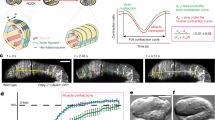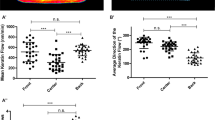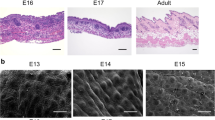Abstract
SKIN wounds in embryos heal rapidly and perfectly. Even though the epidermis appears to be stretched taut over the surface of a structure such as a growing limb bud, its response to wounding is to close over the lesion, rather than to gape more widely. In adult wounds, the epidermis seems to migrate by means of lamellipodia, crawling over the exposed connective tissue1–5. But in embryonic wounds we do not see lamellipodia. The epidermis at the edge of the wound looks smooth, as though under a circumferential tension. Here we show that a cable of filamentous actin appears to run continuously around most of the wound margin. It is confined to the single row of basal cells at the free edge of the epidermis. We suggest that the actin cable acts as a contractile 'purse string' to close up the embryonic wound.
This is a preview of subscription content, access via your institution
Access options
Subscribe to this journal
Receive 51 print issues and online access
$199.00 per year
only $3.90 per issue
Buy this article
- Purchase on Springer Link
- Instant access to full article PDF
Prices may be subject to local taxes which are calculated during checkout
Similar content being viewed by others
References
Odland, G. & Ross, R. J. Cell Biol. 39, 135–151 (1968).
Krawczyk, W. S. J. Cell Biol. 49, 247–263 (1971).
Pang, S. C., Daniels, W. H. & Buck, R. C. Am. J. Anat. 153, 177–192 (1978).
Bereiter-Hahn, J. in Biology of the Integument (eds Bereiter-Hahn, J., Matoltsy, A. G. & Richards, K. S.) 443–471 (Springer, New York, 1986).
Buck, R. C. Invest. Ophthalmol. Vis. Sci. 18, 767–784 (1979).
Gabbiani, G. Int. Rev. Cytol. 48, 187–219 (1977).
Honig, M. G. & Hume, R. I. Trends Neurosci. 12, 333–341 (1989).
Trinkaus, J. P. Cells into Organs: the Forces that Shape the Embryo (Prentice-Hall, Englewood Cliffs, 1984).
Wulf, E., Deboben, A., Bautz, F. A., Faulstich, H. & Wieland, T. Proc. natn. Acad. Sci. U.S.A. 76, 4498–4502 (1979).
Geiger, B., Volk, T., Volberg, T. & Bendori, R. J. Cell Sci. (suppl.) 8, 251–272 (1987).
DiPasquale, A. Expl Cell Res. 94, 191–215 (1975).
Thévenet, A. Archs Anat. microsc. Morph. exp. 70, 227–244 (1981).
Stanisstreet, M., Wakely, J. & England, M. A. J. Embryol. exp Morphol. 59, 341–353 (1980).
Smedley, M. J. & Stanisstreet, M. J. Embryol. exp. Morphol. 83, 109–117 (1984).
Radice, G. P. Devl Biol. 76, 26–46 (1980).
Vaughan, R. B. & Trinkaus, J. P. J. Cell Sci. 1, 407–413 (1966).
Kolega, J. J. Cell Biol. 102, 1400–1411 (1986).
Sherratt, J. A. & Lewis, J. Bull. Math. Biol. (in the press).
Stanisstreet, M. J. Embryol. exp Morphol. 67, 195–205 (1982).
Martin, P. & Nobes, C. D. Mech. Dev. 38, 209–216 (1992).
Komuro, I. et al. J. biol. Chem. 266, 1265–1268 (1991).
Ben-Ze'ev, A. BioEssays 13, 207–212 (1991).
Fristrom, D. Tissue Cell 20, 645–690 (1988).
Bard, J. Morphogenesis: The Cellular and Molecular Processes of Developmental Anatomy (Cambridge Univ. Press, Cambridge, 1990).
Beloussov, L. V., Dorfman, J. G. & Cherdantzev, V. G. J. Embryol. exp. Morphol. 34, 559–574 (1975).
Odell, G. M., Oster, G., Alberch, P. & Burnside, B. Devl Biol. 85, 446–462 (1981).
Maupin-Szamier, P. & Pollard, T. D. J. Cell Biol. 77, 837–852 (1978).
McDonald, K. J. ultrastruct. Res. 86, 107–118 (1984).
Author information
Authors and Affiliations
Rights and permissions
About this article
Cite this article
Martin, P., Lewis, J. Actin cables and epidermal movement in embryonic wound healing. Nature 360, 179–183 (1992). https://doi.org/10.1038/360179a0
Received:
Accepted:
Issue Date:
DOI: https://doi.org/10.1038/360179a0
This article is cited by
-
Epithelial wound healing in Clytia hemisphaerica provides insights into extracellular ATP signaling mechanisms and P2XR evolution
Scientific Reports (2023)
-
Regeneration in calcareous sponge relies on ‘purse-string’ mechanism and the rearrangements of actin cytoskeleton
Cell and Tissue Research (2023)
-
Regenerative Engineering Approaches to Scar-Free Skin Regeneration
Regenerative Engineering and Translational Medicine (2022)
-
From wound response to repair – lessons from C. elegans
Cell Regeneration (2021)
-
Cx43 mediates changes in myofibroblast contraction and collagen release in human amniotic membrane defects after trauma
Scientific Reports (2021)
Comments
By submitting a comment you agree to abide by our Terms and Community Guidelines. If you find something abusive or that does not comply with our terms or guidelines please flag it as inappropriate.



